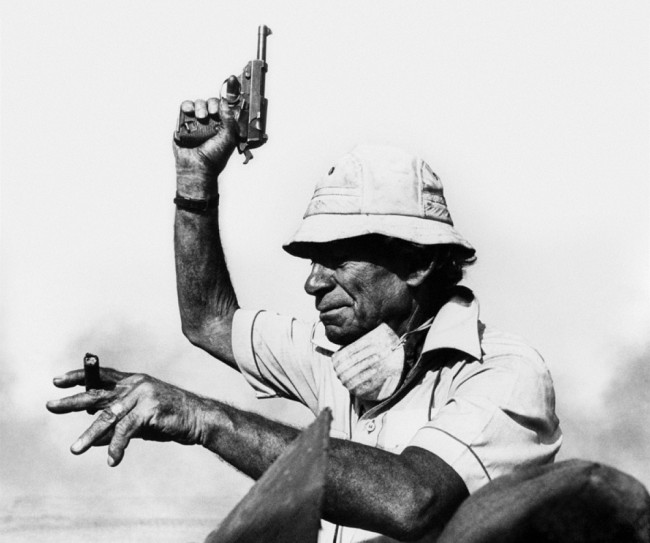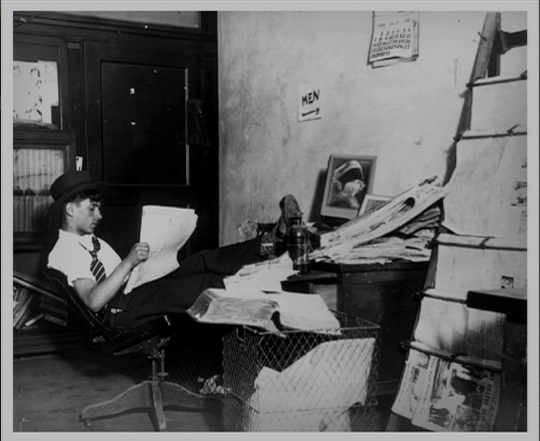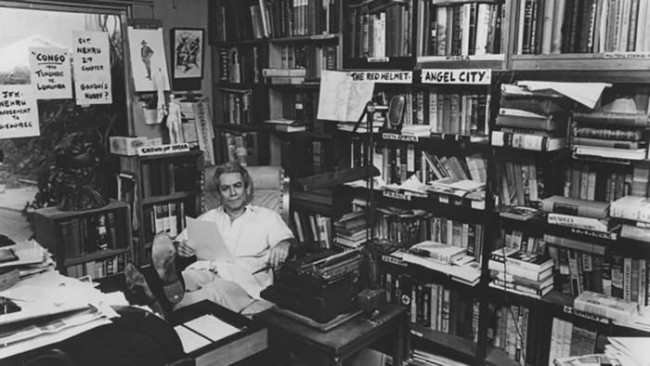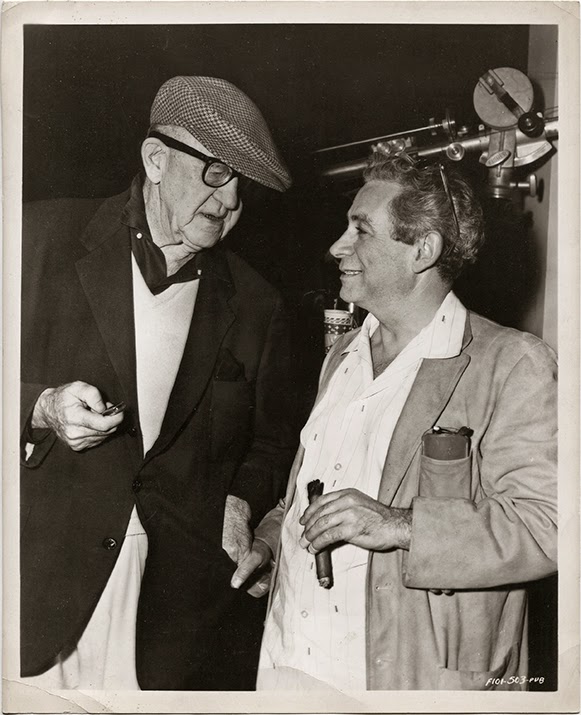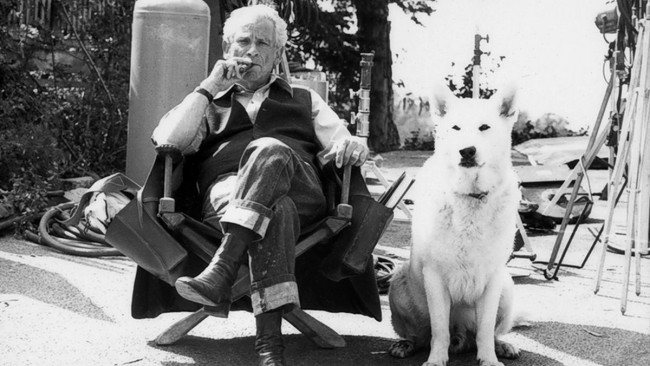‘A film is like a battleground – love…hate…action…violence…death…in one word – emotion!’
– Samuel Fuller in Jean-Luc Godard’s ‘Pierrot le Fou’ (1965)
‘It’s been said that if you don’t like the Rolling Stones, then you just don’t like rock and roll. By the same token, I think that if you don’t like the films of Sam Fuller, then you just don’t like cinema. Or at least you don’t understand it.’
– Martin Scorsese
The summer of 1997 was a real eye-opener. I took my first job as an intern at a production company in Los Angeles, I turned 21 years years old and I discovered the films of Samuel Fuller. I was already completely obsessed with film history but my journey was just getting started and most of the identities of the great filmmakers of the past were still a mystery to me. When I wasn’t working, I scoured the movie listings in the LA Weekly and armed with nothing but a Thomas Guide I learned my way around Los Angeles county hunting down revival houses and feasting on obscure flicks. Prior to the successful reconstruction of the historic Egyptian Theatre, the American Cinematheque hosted their screenings at Raleigh Studios Complex across the street from Paramount Pictures. I saw so many amazing movies for the first time there from Dario Argento’s ‘Suspiria’ (1977) to Werner Herzog’s ‘Lessons of Darkness’ (1992). Their programmers had a lot of credit in the bank with me so when I saw an upcoming retrospective about a director named Samuel Fuller, I bought a few tickets sight unseen to a double-bill of ‘Forty Guns’ (1957) and ‘Hell and High Water’ (1954). I’ve been a western fanatic my entire life but in ‘Forty Guns’ I was exposed to a delirious and convulsive melodrama that defied its genre trappings, a movie so unhinged that it threatened to rip the silver screen in two. ‘Hell and High Water’ did not have the same impact on my imagination, but I was intrigued about another film on the program that was deemed so controversial that it was never released theatrically in the US. Nothing makes me want to see a movie more than being told I’m not allowed to see it so I returned to check out Fuller’s film called ‘White Dog’ (1982). I was completely blown away and knew then and there that I wanted to hunt down every scrap of film ever shot by this iconoclastic visionary. Sadly I missed the screenings where Samuel Fuller made a personal appearance and he died only a few months later when I was back at school. I was devastated that I missed my only chance to hear him speak but that hasn’t stopped me from eagerly listening to him speak through his movies for almost 20 years.
Samuel Fuller is a director’s director in the sense that his filmography has had a profound impact on some of the best directors of the last few decades including but not limited to Martin Scorsese, Jim Jarmusch, Quentin Tarantino & Richard Linklater. These filmmakers who were lucky enough to befriend him always laugh about how it was almost impossible to stop Fuller from telling stories short of physically restraining him. Rarely seen without a cigar wedged in the corner of his mouth, Samuel Fuller was notorious for firing a 9-mm Luger, a war souvenir, to cue his cast and crew instead of shouting, ‘Action!’ There are only a handful of great directors whose larger-than-life personalities threaten to overshadow their work, directors like Werner Herzog and John Huston. I’d argue that there is an easy case to make that Samuel Fuller belongs in their company. He’s one of those rare individuals that appears to have lived the lives of 100 men, each chapter fascinating in its own right. If I were to sum up his career in a few words it would be that he was a man with a singleminded devotion to the truth, no matter what form of reactionary thinking he had to confront and oppose in order to tell it. Without ever sacrificing one ounce of entertainment value in his work, Fuller’s films attack racism, ignorance, hate mongering, totalitarianism, religious fanaticism, and virtually every form of societal prejudice or injustice. He was fiercely proud to be an American, but even more important knew the value and dignity of being a decent human being.
Samuel Fuller is an unusual filmmaker in that being a director was essentially his third career, one that began when he directed his first feature film at the age of 37, ‘I Shot Jesse James’ (1949). His first career started at the tender age of 12 as a newspaper copyboy in New York City. By age 17 he was a crime reporter working for the New York Evening Graphic. It was during that time where he came to view the pursuit of the truth as a noble cause. He used his experiences as inspiration for his work in pulp fiction novels like ‘The Dark Page’, but the attack on Pearl Harbor in 1941 dramatically changed the direction of his life. At age 29 he eagerly enlisted in the army and by November 1942, Samuel Fuller was part of an armada heading toward North Africa to take part in Operation Torch. Fuller experienced several years of intense combat on the front lines, participated in the liberation of concentration camps and would not return home until September of 1945 suffering from horrible nightmares and uncontrollable shakes, a state he describes in his memoirs as, ‘a textbook case of war hysteria.’ His experiences as a journalist and a soldier would inform his world view and his style of storytelling for the rest of life. He suffered zero bullshit in his yarns and offered some of the best insights into storytelling I’ve ever read. My favorite is the advice he gave to Jim Jarmusch, ‘If a story doesn’t give you a hard-on in the first couple of scenes, throw it in the goddamned garbage.’ He recognized that telling stories in movies was completely different than in newspapers or in books, in that movies first and foremost tell stories pictorially. In his autobiography ‘A Third Face’ he describes advice he gave to an aspiring filmmaker where in his classic growl he said, ‘Your script’s got too much gibble-gabble. Show the action, for Chrissakes, don’t describe it! It’s a motion picture you’re making, not a goddamned radio show. A motion picture with emotion, so let your characters speak from their hearts.’ He loved the art of storytelling and admitted that he was at his happiest smoking a cigar while smashing the keys of his typewriter.
In Samuel Fuller’s best work we have films that I find that grow with the passage of time. There’s never been a filmmaker before or since that was so hellbent upon punching the audience in the face with facts and ideas that they might not be comfortable with acknowledging. In one of his earliest films ‘The Steel Helmet’ (1951) Samuel Fuller’s characters candidly discuss Japanese internment camps in the United States and the barbarism inherent in the Jim Crows laws of the South, sad realities that were not typically explored by Hollywood at that time. Fuller’s refusal to compromise when it came to the truth led to his frequently bucking the formulas of the Hollywood system. Today Samuel Fuller has a reputation as one of the greatest early independent filmmakers, and that reputation is well-deserved from the latter part of his career, but what a lot of people fail to acknowledge is that from the mid-Forties to the early Sixties, Samuel Fuller was a creature of the Hollywood studio system including a contract to make seven films for producer Darryl Zanuck, films that form the backbone of Fuller’s filmography. He came very close to adapting Hemingway’s ‘The Sun Also Rises’ for director Howard Hawks but lost the gig when he informed Hawks he intended to open the script with the character Jake Barnes lying naked on an operating table as a nurse, Lady Brett Ashley, removes one of his testicles and drops it into a tin cup. Fuller, rightly or wrongly, thought it was dishonest to keep this information hidden from the audience as it was in much of the book. We can add that movie to the long list of classics we’ll never see. What’s incredible is how much he got away with and how frequently he was attacked for being anti-American for simply telling the truth as he saw it. He despised the communist witch hunts of the 1950s and in classics such ‘Pickup on South Street’ (1953), he attacked the phony patriotism of those pursuing that agenda. Fortunately his war record, which included the Bronze Star, the Silver Star, and a Purple Heart, was the perfect shield against his critics. J. Edgar Hoover famously wanted ‘Pickup on South Street’ to be heavily censored but Darryl Zanuck informed him that he was not in the business of making propaganda films. Fuller shares the experience in the video below from ‘A Personal Journey with Martin Scorsese Through American Movies’ (1995):
I get frustrated when I see how few alleged movie enthusiasts know Sam Fuller’s work or even worse, dismiss him outright. His movies have more guts, more honesty and more entertaining shock value than almost any films being made in the 21st century. So I thought I should put together a brief list of my favorite movies of his in order to invite a few more cinephiles into the club, a club that they will never want to leave once they become a member. I’ve already mentioned some of his essential classics such as ‘The Steel Helmet’, ‘Pickup on South Street’, & ‘Forty Guns’. But there are other movies that are absolutely worth hunting down like ‘Park Row’ (1952), his love song to the newspaper business as well as his many films about men in combat, the greatest of which captures his own WWII experiences, ‘The Big Red One’ (1980) which was sadly underfunded but remains essential viewing nonetheless. While I love all of these movies, his greatest work for me are those movies that are the most subversive and uncompromising in addressing the sicknesses at the heart of the democracy that he loved so dearly. Luckily all 3 of these movies have been lovingly restored and rereleased by The Criterion Collection. I’m talking about ‘Shock Corridor’, ‘The Naked Kiss’ and ‘White Dog’, three movies that you will never forget.
Shock Corridor (1963)
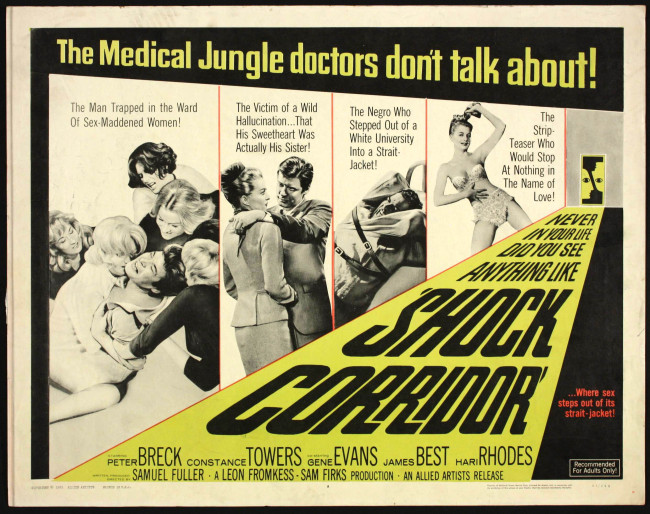
Shot in only ten days with no stars and very little money, ‘Shock Corridor’ is the beginning of Samuel Fuller’s career as an independent filmmaker. The story follows a journalist who feigns insanity and checks into an asylum in order to investigate a murder that was witnessed by some of the inmates. Once inside, we see a nightmarish vision of the dark side of America with a fascinating story that explores cold war paranoia, racism and the imminent threat of nuclear annihilation. In easily the most shocking sequence we see the character of Trent, a Black man who has retreated from the horrors of racism by taking on the identity of a White member of the KKK.
After a horrifying outburst and leading an attack on a Black orderly at the asylum, Trent calms down and has a moment of lucidity where he becomes himself again. He describes his own feelings of failure and how he was brought up to love and have pride in his country even when confronted with a sickness like segregation. In his autobiography Samuel Fuller writes:
‘Trent is speaking for me and intelligent, sensitive people all over the world who feel the same about their countries, too. Despite some wrongheaded politicians, misguided wars, and small-minded laws, I love my country. Nothing and nobody can take that deep love away from me. But, goddamnit, this nation gives me ulcers sometimes!’ – Samuel Fuller ‘A Third Face’
For those interested in film history, John Ford paid a visit to Samuel Fuller while he was shooting and informed Fuller that they were working on the same soundstage where he shot ‘The Informer’ (1935), a film that he fought to make in the same way Fuller fought to make ‘Shock Corridor’. Another interesting fact is that this film was shot by the great Stanley Cortez (‘The Magnificent Ambersons’ (1942), ‘The Night of the Hunter’ (1955)) who is responsible for making ‘Shock Corridor’ one of the most interesting films visually in Fuller’s career.
The Naked Kiss (1964)
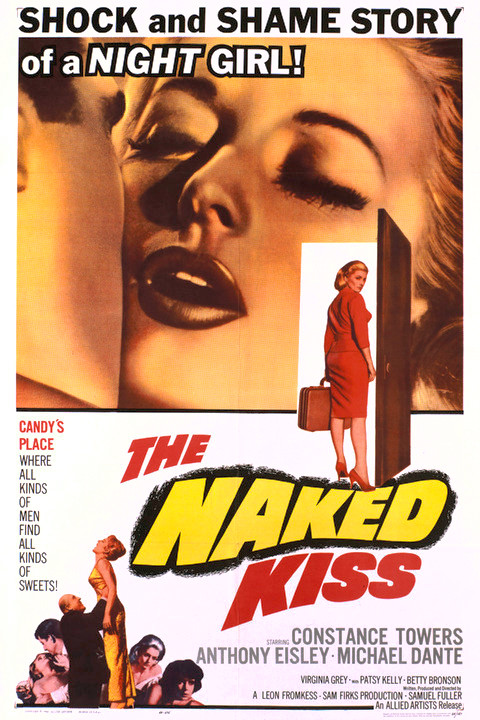
At last we come to my favorite movie by Samuel Fuller, ‘The Naked Kiss’. As a crime reporter Samuel Fuller knew a lot of women who made a living working as prostitutes and often used them as informants. He’d bring the girls coffee and donuts for breakfast and after getting a good lead on a story would make calls from the brothels around Manhattan. He befriended many of these girls and went so far as to help a few make a fresh start when they’d had enough of that lifestyle. In his memoirs Fuller describes his disgust at the the small mindedness of society, a society that more often than not chose to attack women trapped in this lifestyle in an effort to promote hate and intolerance toward them all while pretending not to be partaking in the services they offer.
‘The Naked Kiss’ features the most famous opening shots of Fuller’s career (see video above) as Kelly (played by Constance Towers) beats her pimp to the ground for having shaved her head bald for resisting his authority. After this explosive opening, the film presses down on the accelerator and never lets up as Kelly tries to start a new life in a small town only to get mired in a scandal for murdering a child molester who happens to be one of the town’s leading citizens. Without question, this is my favorite melodrama I’ve ever seen and for me the signature film of Samuel Fuller’s career.
White Dog (1982)
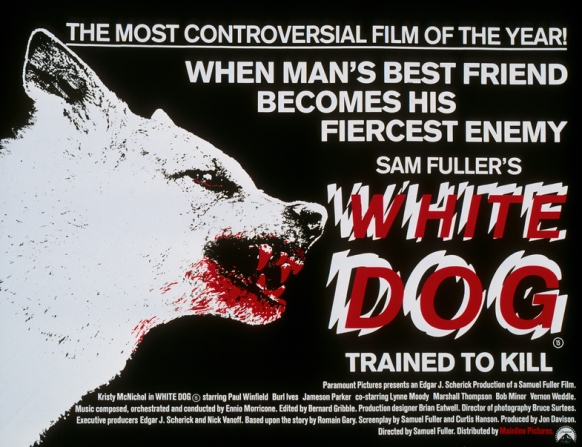
Few things irritate me more than when people make up their minds to be offended and outraged by a movie when they have not yet bothered to see the film in question. Such was the case with ‘White Dog’, an exposé on racism about a white german shepherd trained by a hate group to kill Black people and the courageous Black animal trainer, played brilliantly by Paul Winfield, that tries to undo the damage. What’s unfortunate is that this movie attacks the very bigotry and ignorance that is opposed by groups such as the NAACP, yet critics nonetheless deliberately chose to misinterpret the film and threatened to boycott the movie should it ever be released. Paramount caved, decided they were uninterested in the controversy and put the movie on a shelf to rot. What’s most infuriating about what happened to the movie is that the film was criticized for spreading the type of racist ideas that Samuel Fuller spent his entire life opposing, the exact type of ugly distortion of the facts and truth that filled the reporter side of Fuller with disgust. Thankfully the film was rediscovered over time. The reality is that this is an incredibly moving movie with a great screenplay by the young Curtis Hanson and an amazing score by Ennio Morricone. The Criterion Collection has done the hard work of making this movie available to us. Now it up to you to hunt it down and watch it.
Richard Linklater introducing ‘White Dog’ at the Austin Film Society:
* * *
Like with any great filmmaker, my study of their work is never complete. I’m still hunting down a few of his movies that I have failed to see like ‘Fixed Bayonets!’ (1951) and ‘Run of the Arrow’ (1957). While Fuller’s films were hard to find when I began my film studies most of his work is now readily available online with a little digging. It will be a sad day when I no longer have any new movies of his to look forward to seeing but his best movies are endlessly rewarding upon multiple viewings and I continue to find his attitudes and ideas more inspiring than ever. So I think I’ve rambled enough at this point although I reserve the right to return to this post and make additions as needed. For now I’ll close with a few inspiring words from the man himself.
‘I’ve seen my fellow Americans at their best and at their worst. Their enthusiasm, gutsiness, ingeniousness, and sheer industry are truly remarkable. Yet into the fabric of my times have been woven devastating world wars, poverty and ignorance, social rifts based on race and wealth, psychopathic hate groups like the Ku Klux Klan, political witchhunters and religious fanatics. For me, the hatemongers and reactionaries are the most loathsome, thorns in the eye of a great democracy. Every generation will have their own. They must be fought and defeated.’
– Samuel Fuller ‘A Third Face’
One of the best documentaries on Fuller including interviews with Martin Scorsese, Jim Jarmusch, and Quentin Tarantino:
I am one of the Co-Hosts of Wrong Reel and you can find our content here:


